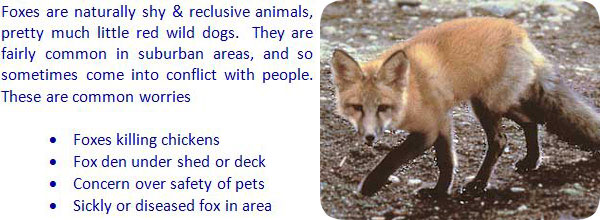- info@wildlifeanimalcontrol.com
Call us for help in your town
Wildlife Control Education
How to Get Rid of Foxes

It is my goal to educate the public about foxes and other wildlife, and
provide tips for safe, effective, and responsible wildlife removal.
Summary of Step-By-Step Instructions:
1) Purchase large cage traps - rated raccoon size or above, usually about 12" x 12" x 36" or so.
2) Set traps with meat-based bait in areas of fox activity. Make sure traps are scent-free and flush to the ground, and set in the shade.
3) Relocate any trapped fox at least 10 miles from capture site. Please be mindful of the possibility of a fox den with pups before trapping and relocating a lactating female fox.
4) If you have fox living under a deck, shed, or other structure, install an exclusion barrier - steel mesh around the perimeter, and down at least 12 into the ground, with bottom of mesh sloping outward.
Need fox removal in your hometown? We service over 500 USA locations! Click here to hire us in your town and check prices - updated for year 2020.
How to Get Rid of Foxes - Foxes have played a very big part of our culture and our economy, but they are also considered pests. Foxes have been the star in many children's stories, cartoons and are usually portrayed as tricksters and thieves. Foxes are small, skinny creatures that are found in many parts of the world. They can be a variety of colors, but the most common color of their coat is an orangey brown color with white paws, faces and the tips of the tail. Foxes have lost almost all their fear of humans and now associate them with food. It is this lack of fear that foxes have that make them nuisances to the farmer and the gardener.
Foxes are the enemy of farmers and livestock breeders as foxes eat chickens, rodents, eggs and rabbits which are all essential parts of a farmer's livelihood. They will also dig holes and break into your garbage cans if they have the opportunity. Foxes are opportunist hunters and foragers and will snag anything that looks good to them. Foxes can also dig holes for their burrows and they will do this under your house or your porch which can damage the foundation and support beams. If you have a fox problem, try a few of these suggestions to get rid of them in a hurry:

- An easy way to keep a fox out of your yard is to fence it out. This is expensive, but it will keep all critters, not just foxes, out of your yard. You can go with a traditional white picket fence if you like or just a simple wire mesh fence will do the trick. However, a fence is not a fool proof way to keep the foxes out if they really want to eat something in your yard. A taller fence will keep the high jumpers out.
- You can scare the foxes away with keeping large dogs in your yard or using a motion activated sprinkler system that will spray them when they come near. You can strategically place them where the fox likes to get under your house or where they break into your chicken coop.
- You can buy a fox repellent that is a synthetic chemical or a natural predator scent. However, these repellents rarely work and the ones that do wear off quickly. Only use repellents in conjunction with other pest removal methods.
- If none of the above methods work, you will have to resort to more drastic measures. You can trap the fox with a large cage that you must wash with soap before you set up to get the human scent off of it. Dig a shallow hole and put some meat in it and cover the hole with the cage. You will not be able to relocate the fox so you will have to shoot it.
- If you don't want to shoot the fox you can poison it. You can poison a piece of meat that you know the fox will get or you can poison the rats around your home and the foxes will eat the rats and indirectly consume the poison. However, be very careful that your beloved family pet doesn't get a hold of the poisoned meat or the poisoned rat.
- If you don't have the stomach to shoot or poison the fox then you can hire a professional pest removal expert to do it for you. You can also hire the pest removal expert to set the traps and deal with all the hassle so you do not have to.
More in-detail how-to fox removal articles:
Information about fox trapping - analysis and methods for how to trap.
Information about how to kill a fox - with poison or other methods.
Information about how to keep foxes away - prevention techniques.
Information about how to catch a fox - remove one stuck in the house.
Information about fox repellent - analysis of types and effectiveness.

Fox Information & Facts
Fox Appearance: The fox is a dog-like mammal weighing twelve pounds on average. Most species have a characteristic face with a pointed muzzle, large, almond shaped eyes, and large ears. The hair coat coloration will depend on the area of habitat, and will be composed of colors that mimic natural surroundings. The coat of the red fox may seem contradictory to this rule, but the coat color of these foxes is usually varying shades of auburn and is well suited to blend in with forest undergrowth. The fur undergoes various color stages, and a red fox may not appear red during other times of the year. All foxes have outer guard hairs, a layer of shielding hair which provides protection from the elements. Their heads, though remarkably like dogs, have a concave appearance rather than the dog muzzle which is convex. North American foxes have short legs and long, bushy tails.
Fox Habitat and Behavior: Foxes are commonly social creatures, living in family groups within a given territory, but some of them will become nomadic and solitary. Regardless of the territory orientation, they will use scent markings to communicate to other foxes and to mark empty food plots. Like many other animals, foxes will cart food to a specific location and bury the meal rather than catching prey and eating it onsite. Most commonly, a fox will carry food to the den site, but only for immediate consumption. Foxes avoid storing food within their dens for fear of drawing in other predators. These community animals will tolerate the presence of less dominate males inside the territory, but these other males are usually from a prior litter. The dominant male will allow the foxes within his territory to assist with the raising of more recent young.
Foxes communicate with one another as most members of the canine family do. Using body language and a hierarchy of dominance, the fox is able to effectively maintain an organized group structure. Body language which demonstrates fear is often misinterpreted by humans as aggression. When fearful, the fox will arch its back and bare its teeth, posturing sideways. An aggressive fox will attack directly, tail aloft and ears forward.
Foxes have one litter a year. The litter size is approximately six kits. The dominant male of the group will breed with the dominant female. Any subordinate females that are bred rarely give birth, and if they do, the dominant female will likely kill the offspring.
Fox Diet: Most foxes are omnivorous. They are capable hunters, often feeding on small mammals, snakes, birds, and amphibians. A fox is also opportunistic, and will not pass up a meal of carrion. Berries make up a large part of the seasonal diet when they are available.
A hunting fox will stalk its prey prior to initiating a quick pounce that kills the animal. A rodent vocalization can be heard by a fox forty yards away, immediately revealing the location of the prey. Once the target is located, the fox will sneak as close as five yards and then launch into the air, coming down on the other animal with the full force of its body. This hunting tactic is taught early in the fox's life during play with siblings.

Fox Nuisance Concerns: Because the fox is an omnivore, the desire to eat meat of small game has made it a nuisance to mankind. Many poultry farms are subject to fox raids, and smaller operations such as rabbit farms also boast concerns about the creature. Game farms and preserves for both small mammals and birds can find the intrusion of a fox problematic. Homeowners with outdoor rabbit hutches or mobile chicken coops are often easy targets for predation.
Fox Diseases: In certain countries, foxes are the main carrier of rabies, though they are also known to carry leptospirosis and tularemia. Foxes themselves are subject to suffer from many tick borne diseases, and can spread disease by facilitating tick movement. Foxes can harbor canine distemper virus, a disease that is particularly deadly to young and unvaccinated dogs.
A reader had this to say about foxes and ticks and she is correct: "Foxes are actually the only animal that can truly keep rodent population under control. Bad for your business? It is bad for any eco-system to get rid of foxes. You are not experts on ecology or foxes and make stuff up???? Foxes "are subject to suffer from many tick borne diseases, and can spread disease by facilitating tick movement". You this horrible and wrong information about foxes to scare people? to make people hate foxes? As though they are just bad and have no place in the world and eco-system? They have ever right to be here and they do more good in the world than humans. Do your research, foxes are the only animal that lowers the amount of ticks in an area. Foxes are the most important factor in control and reducing lyme disease and other deadly tick related disease. The first stage of a ticks lifecycle is on rodents and that is when ticks catch the diseases and pass it on to humans. Foxes kill off most rodents where ever they live!!!"
You're here to learn how to get rid of foxes in the yard or garden. This site is intended to provide fox education and information, so that you can make an informed decision
if you need to deal with a fox problem. This site provides many fox control articles and strategies, if
you wish to attempt to solve the problem yourself. If you are unable to do so, which is likely with many
cases of fox removal, please go to the home page and click the USA map, where I have wildlife removal experts
listed in over 500 cites and towns, who can properly help you with your nuisance fox.
Learn more about the fox and how to take care of your fox problem through my educational articles. I can show you how to identify fox tracks and how to get foxes out from under a Shed or a Porch. Learn how to get rid of Foxes and all about Fox Repellants. Find out if a fox that is active during the day rabid, and even if foxes make good pets. Learn where foxes live, how to Kill a Fox, and if a fox should be Domesticated. Read about Diseases Foxes Carry, if foxes are dangerous to pets, and how to keep foxes Away From Your Property.

















